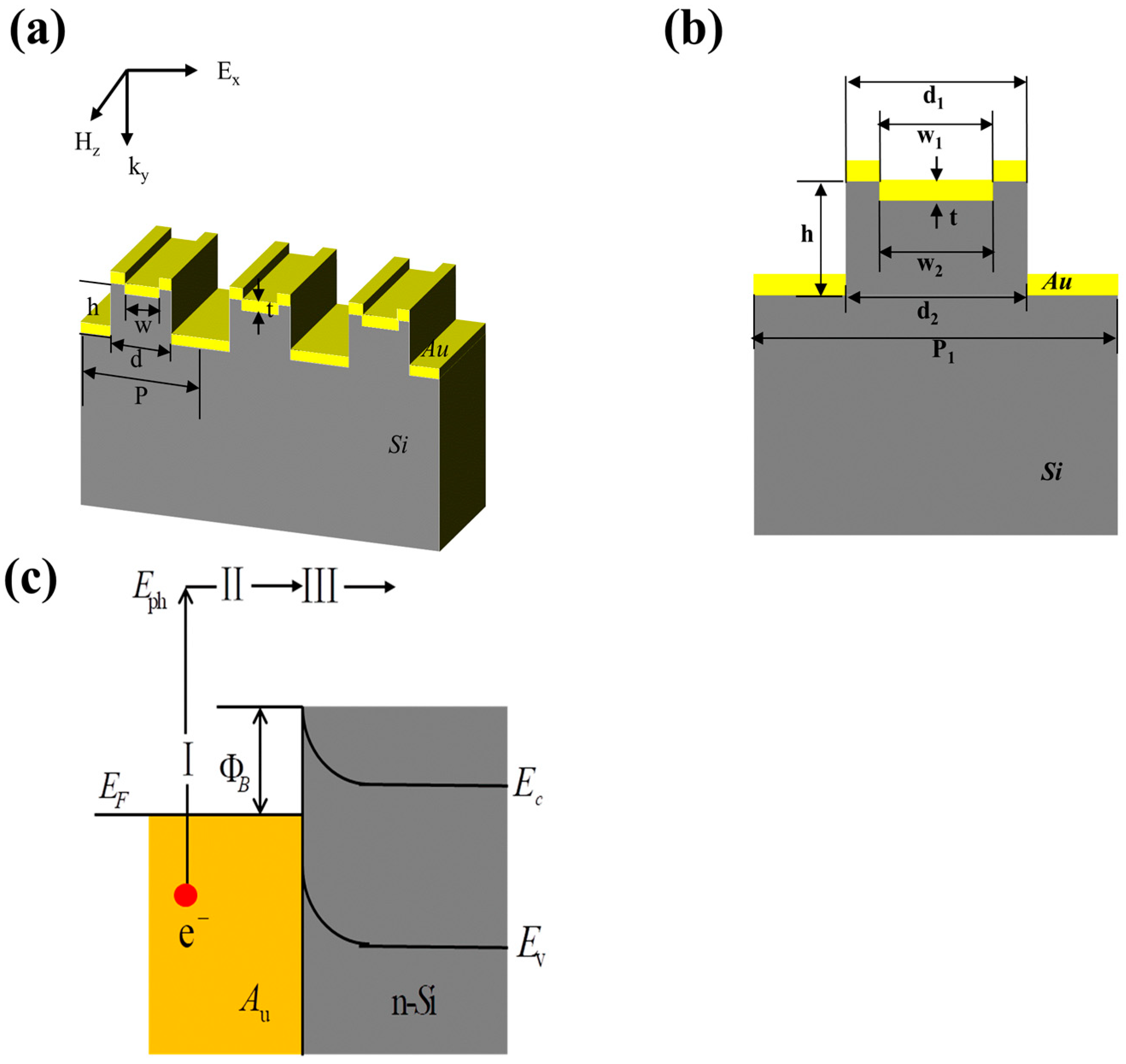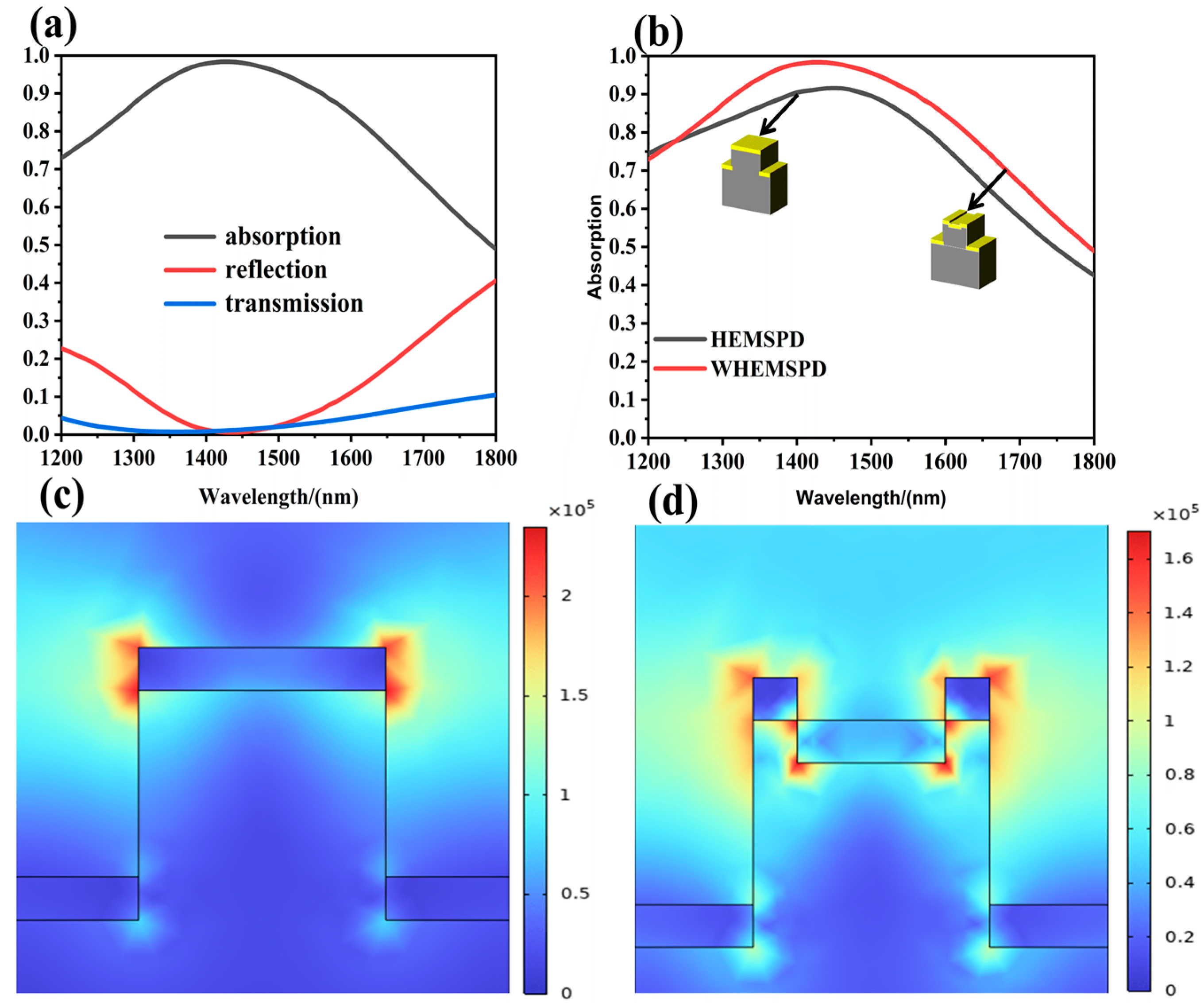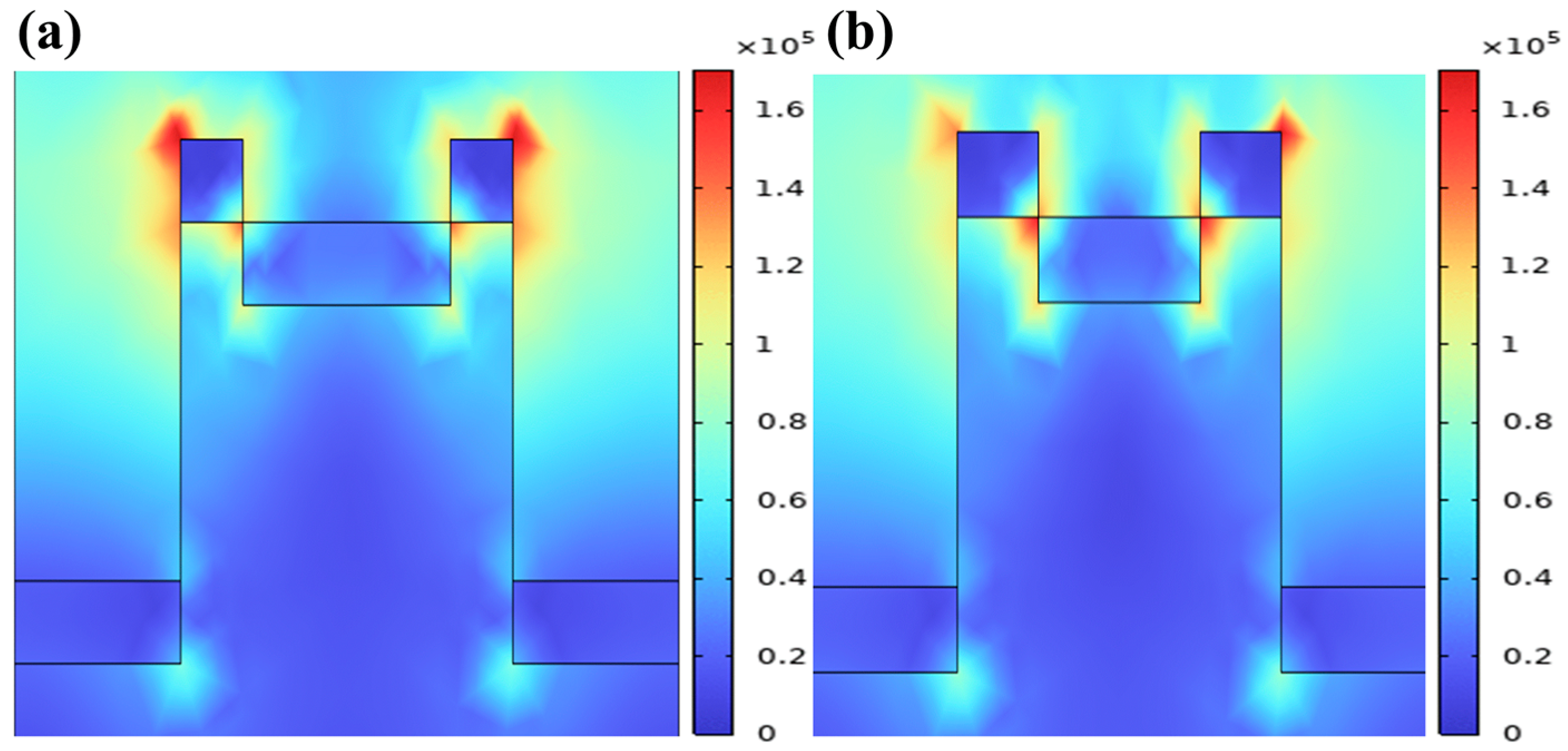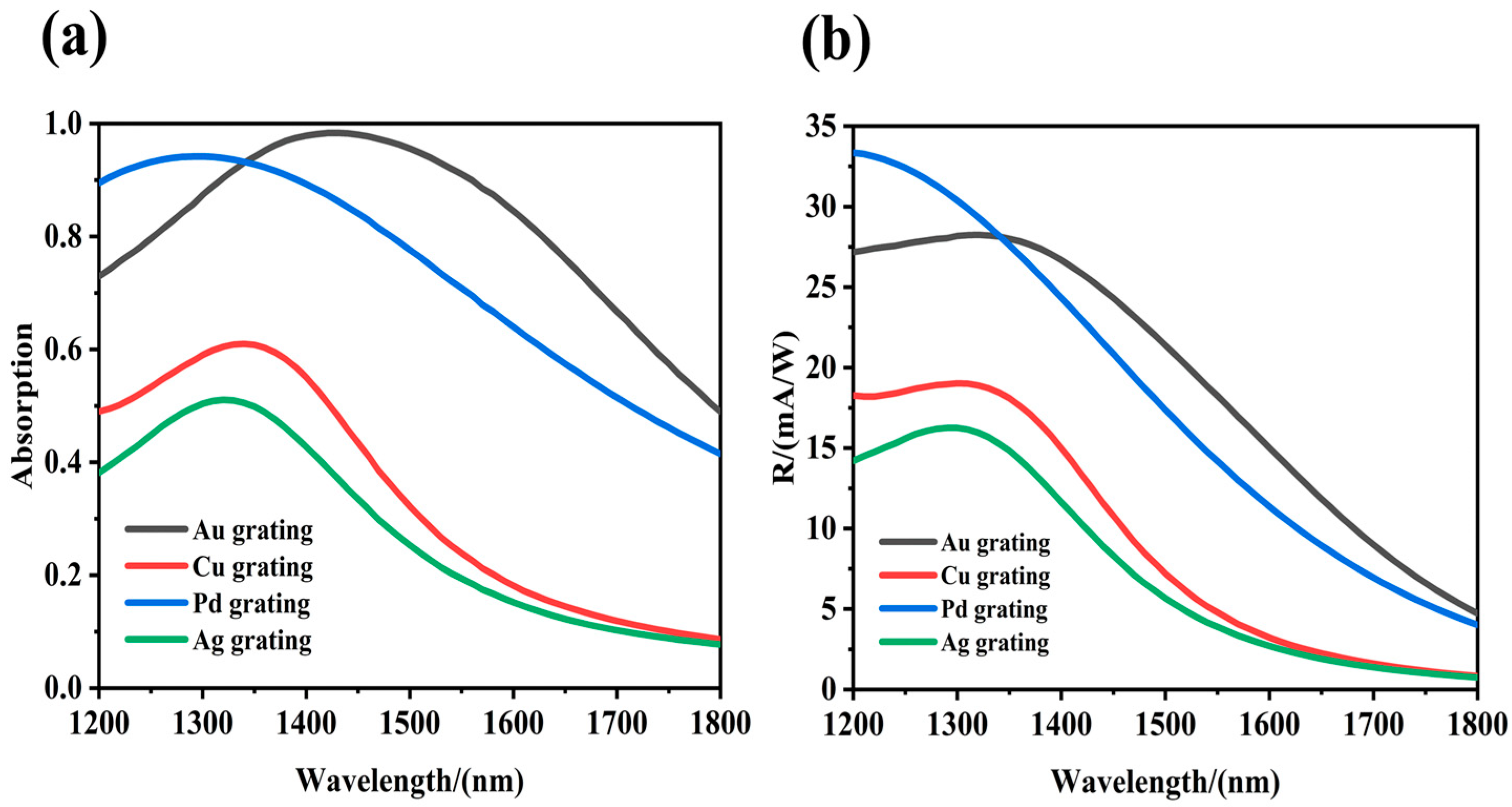Wideband Near-Infrared Hot-Electron Photodetector Based on Metal Grating Structure
Abstract
1. Introduction
2. Models and Methods
3. Results and Discussion
4. Electrical Analysis
| Device Structure | Wavelength Range (A > 0.9) | R | D* | Ref. |
|---|---|---|---|---|
| WHEMSPD Au/Si | 1320–1550 nm | 28.3 mA/W@1320 nm | 6.51 × 108 Jones | This work |
| HEMSPD Au/Si | 1400–1500 nm | 27.7 mA/W@1200 nm | 6.40 × 108 Jones | This work |
| MetamaterialAu/Si | 1440–1540 nm | 3.37 mA/W@1470 nm (cal.) | N/A | [2] |
| Nanoislands Au/S | N/A | 3.5 mA/W@1200 nm | 8.74 × 107 Jones (cal.) | [38] |
| Au grating/p-Si | N/A | 13 mA/W@1550 nm | 6.82 × 106 Jones (cal.) | [39] |
| Au stripe/p-Si | N/A | 12 mA/W@1550 nm | 3.87 × 106 Jones (cal.) | [40] |
| GaAs nanocone/MLG | N/A | 1.73 mA/W@850 nm | 1.83 × 1011 Jones | [41] |
| Au asymmetric stripe/p-Si | N/A | 15.2 mA/W@1310 nm (cal.) | 1.17 × 107 Jones (cal.) | [42] |
| Nanostructure VO2/MoS2 | 810–850 nm | 3.4 mA/W@820 nm | N/A | [43] |
| Nanopillar Au/Si | 0 | 2.5 mA/W@1310 nm | N/A | [44] |
| Double-cavity HEPD MoS2 | 780–800 nm/968–1008 nm | 23.6 mA/W@988 nm | N/A | [45] |
5. Conclusions
Author Contributions
Funding
Institutional Review Board Statement
Informed Consent Statement
Data Availability Statement
Conflicts of Interest
References
- Ai, Z.; Liu, H.; Cheng, S.; Zhang, H.; Yi, Z.; Zeng, Q.; Wu, P.; Zhang, J.; Tang, C.; Hao, Z. Four peak and high angle tilted insensitive surface plasmon resonance graphene absorber based on circular etching square window. J. Phys. D Appl. Phys. 2025, 58, 185305. [Google Scholar] [CrossRef]
- Li, W.; Valentine, J. Metamaterial perfect absorber based hot electron photodetection. Nano Lett. 2014, 14, 3510–3514. [Google Scholar] [CrossRef]
- Knight, M.W.; Sobhani, H.; Nordlander, P.; Halas, N.J. Photodetection with Active Optical Antennas. Science 2011, 332, 702–704. [Google Scholar] [CrossRef]
- Wang, F.; Melosh, N.A. Plasmonic Energy Collection through Hot Carrier Extraction. Nano Lett. 2011, 11, 5426–5430. [Google Scholar] [CrossRef]
- McFarland, E.W.; Tang, J. A photovoltaic device structure based on internal electron emission. Nature 2003, 421, 616–618. [Google Scholar] [CrossRef] [PubMed]
- Clavero, C. Plasmon-induced hot-electron generation at nanoparticle/metal-oxide interfaces for photovoltaic and photocatalytic devices. Nat. Photonics 2014, 8, 95–103. [Google Scholar] [CrossRef]
- Li, J.; Cushing, S.K.; Zheng, P.; Meng, F.; Chu, D.; Wu, N. Plasmon-induced photonic and energy-transfer enhancement of solar water splitting by a hematite nanorod array. Nat. Commun. 2013, 4, 2651. [Google Scholar] [CrossRef] [PubMed]
- Mubeen, S.; Lee, J.; Singh, N.; Kramer, S.; Stucky, G.D.; Moskovits, M. An autonomous photosynthetic device in which all charge carriers derive from surface plasmons. Nat. Nanotechnol. 2013, 8, 247–251. [Google Scholar] [CrossRef]
- Giugni, A.; Torre, B.; Toma, A.; Francardi, M.; Malerba, M.; Alabastri, A.; Zaccaria, R.P.; Stockman, M.I.; Di Fabrizio, E. Hot-electron nanoscopy using adiabatic compression of surface plasmons. Nat. Nanotechnol. 2013, 8, 845–852. [Google Scholar] [CrossRef]
- Schuck, P.J. Hot electrons go through the barrier. Nat. Nanotechnol. 2013, 8, 799–800. [Google Scholar] [CrossRef]
- Ueno, K.; Misawa, H. Plasmon-enhanced photocurrent generation and water oxidation from visible to near-infrared wave-lengths. NPG Asia Mater. 2013, 5, e61. [Google Scholar] [CrossRef]
- Knight, M.W.; Wang, Y.; Urban, A.S.; Sobhani, A.; Zheng, B.Y.; Nordlander, P.; Halas, N.J. Embedding Plasmonic Nanostructure Diodes Enhances Hot Electron Emission. Nano Lett. 2013, 13, 1687–1692. [Google Scholar] [CrossRef] [PubMed]
- Lin, K.T.; Chen, H.L.; Lai, Y.S.; Yu, C.C. Silicon-based broadband antenna for high responsivity and polarization-insensitive photodetection at telecommunication wavelengths. Nat. Commun. 2014, 5, 3288. [Google Scholar] [CrossRef]
- Ahmadivand, A.; Sinha, R.; Vabbina, P.K. Hot electron generation by aluminum oligomers in plasmonic ultraviolet photodetectors. Opt. Express 2016, 24, 13665–13678. [Google Scholar] [CrossRef]
- Hu, M.; Yang, L.; Dai, H.; He, S. Broadband absorption and efficient hot-carrier photovoltaic conversion based on sunlight-induced non-radiative decay of propagating surface plasmon polaritons. Sci. Rep. 2017, 7, 4809. [Google Scholar] [CrossRef]
- Wen, L.; Chen, Y.; Liang, L.; Chen, Q. Hot Electron Harvesting via Photoelectric Ejection and Photothermal Heat Relaxation in Hotspots-Enriched Plasmonic/Photonic Disordered Nanocomposites. ACS Photonics 2018, 5, 581. [Google Scholar] [CrossRef]
- Desiatov, B.; Goykhman, I.; Mazurski, N.; Shappir, J.; Khurgin, J.B.; Levy, A. Plasmonic enhanced silicon pyramids for internal photoemission Schottky detectors in the near-infrared regime. Optica 2015, 2, 335. [Google Scholar] [CrossRef]
- Li, Z.; Cheng, S.; Zhang, H.; Yang, W.; Yi, Z.; Yi, Y.; Wang, J.; Ahmad, S.; Raza, R. Ultrathin broadband terahertz metamaterial based on single-layer nested patterned graphene. Phys. Lett. A 2025, 534, 130262. [Google Scholar] [CrossRef]
- Zeng, Z.; Li, H.; Zhang, H.; Cheng, S.; Yi, Y.; Yi, Z.; Wang, J.; Zhang, J. Tunable ultra-sensitive four-band terahertz sensors based on Dirac semimetals. Photonics Nanostructures-Fundam. Appl. 2025, 63, 101347. [Google Scholar] [CrossRef]
- Cheng, S.; Li, W.; Zhang, H.; Akhtar, M.N.; Yi, Z.; Zeng, Q.; Ma, C.; Sun, T.; Wu, P.; Ahmad, S. High sensitivity five band tunable metamaterial absorption device based on block like Dirac semimetals. Opt. Commun. 2024, 569, 130816. [Google Scholar] [CrossRef]
- Sayed, S.Y.; Wang, F.; Malac, M. Heteroepitaxial Growth of Gold Nanostructures on Silicon by Galvanic Displacement. ACS Nano 2009, 3, 2809–2817. [Google Scholar] [CrossRef] [PubMed]
- Wen, X.H.; Jia, Y.; Yu, L.Y.; Shao, L.; Chen, H.; Xia, C.J.; Tang, L.I.; Shi, H.F. Silicon based hot electron short wave infrared detection technology (cover paper·invited). Infrared Laser Eng. 2024, 53, 9–30. [Google Scholar]
- Zhang, C.; Cao, G.; Wu, S.; Shao, W.; Giannini, V.; Maier, S.A.; Li, X. Thermodynamic loss mechanisms and strategies for efficient hot-electron photoconversion. Nano Energy 2019, 55, 164–172. [Google Scholar] [CrossRef]
- Tao, Z.; Zhou, D.; Yin, H.; Cai, B.; Huo, T.; Ma, J.; Di, Z.; Hu, N.; Yang, Z.; Su, Y. Graphene/GaAs heterojunction for highly sensitive self-powered Visible/NIR photodetectors. Mater. Sci. Semicond. Process. 2020, 111, 104989. [Google Scholar] [CrossRef]
- Chalabi, H.; Schoen, D.T.; Brongersma, M.L. Hot-electron photodetection with a plasmonic nanostripe antenna. Nano Lett. 2014, 14, 1374–1380. [Google Scholar] [CrossRef]
- Scales, C.; Berini, P. Thin-Film Schottky Barrier Photodetector Models. IEEE J. Quantum Electron. 2010, 46, 633–643. [Google Scholar] [CrossRef]
- Sun, Q.X.; Zhang, C.; Shao, W.J.; Li, X.F. Photodetection by Hot Electrons or Hot Holes: A Comparable Study on Physics and Performances. ACS Omega 2013, 4, 6020–6027. [Google Scholar] [CrossRef] [PubMed]
- Zhang, C.; Luo, Y.; Maier, S.A.; Li, X. Recent Progress and Future Opportunities for Hot Carrier Photodetectors: From Ultraviolet to Infrared Bands. Laser Photonics Rev. 2022, 16, 2100714. [Google Scholar] [CrossRef]
- Roh, S.; Chung, T.; Lee, B. Overview of the Characteristics of Micro- and Nano- Structured Surface Plasmon Resonance Sensors. Sensors 2011, 11, 1565–1588. [Google Scholar] [CrossRef]
- Sobhani, A.; Knight, M.W.; Wang, Y.; Zheng, B.; King, N.S.; Brown, L.V.; Fang, Z.; Nordlander, P.; Halas, N.J. Narrowband photodetection in the near-infrared with a plasmon-induced hot electron device. Nat. Commun. 2013, 4, 1643. [Google Scholar] [CrossRef]
- Crowell, C.R.; Spitzer, W.G.; Howarth, L.E.; LaBate, E.E. Attenuation length measurements of hot electrons in metal films. Phys. Rev. 1962, 127, 2006–2015. [Google Scholar] [CrossRef]
- Stuart, R.N.; Wooten, F.; Spicer, W.E. Mean free path of hot electrons and holes in metals. Phys. Rev. Lett. 1963, 10, 7–9. [Google Scholar] [CrossRef]
- Furube, A.; Du, L.; Hara, K. Ultrafast Plasmon-Induced Electron Transfer from Gold Nanodots into TiO2 Nanoparticles. J. Am. Chem. Soc. 2007, 129, 14852–14853. [Google Scholar] [CrossRef] [PubMed]
- Chen, L.; Mao, S.; Shen, Z.; Zhang, Q.Z.; Zhang, C.; Wang, P.; Belfiore, L.A.; Tang, J.G. Isolate Utilization of Plasmonic Hot Holes in Optoelectronic Enhancement for Copper Iodide (CuI): A Cross-Investigation by Confocal Kelvin Probe Force Microscopy. Adv. Opt. Mater. 2023, 11, 2300230. [Google Scholar] [CrossRef]
- Chen, L.; Mao, S.; Wang, P.; Yao, Z.; Du, Z.L.; Zhu, Z.J.; Belfiore, L.A.; Tang, J.G. Visible Light Driven Hot-Electron Injection by Pd Nanoparticles: Fast Response in Metal–Semiconductor Photodetection. Adv. Opt. Mater. 2021, 9, 2001505. [Google Scholar] [CrossRef]
- Johnson, P.B.; Christy, R.W. Optical Constants of the Noble Metals. Phys. Rev. B 1972, 6, 4370–4379. [Google Scholar] [CrossRef]
- Weaver, J.H. Optical properties of Rh, Pd, Ir, and Pt. Phys. Rev. B 1974, 9, 1782–1792. [Google Scholar] [CrossRef]
- Nazirzadeh, M.A.; Atar, F.B.; Turgut, B.B.; Okyay, A.K. Random sized plasmonic nanoantennas on Silicon for low-cost broad-band near-infrared photodetection. Sci. Rep. 2014, 4, 7103. [Google Scholar] [CrossRef]
- Alavirad, M.; Olivieri, A.; Roy, L.; Berini, P. High-responsivity sub-bandgap hot-hole plasmonic Schottky detector. Opt. Express 2016, 24, 22544–22554. [Google Scholar] [CrossRef]
- Othman, N.; Berini, P. Nanoscale Schottky contact surface plasmon “point detectors” for optical beam scanning applications. Appl. Opt. 2017, 56, 3329–3334. [Google Scholar] [CrossRef]
- Luo, L.; Chen, J.; Wang, M.; Hu, H.; Wu, C.; Li, Q.; Wang, L.; Huang, J.; Liang, F. Near-infrared light photovoltaic detector based on GaAs nanocone array/monolayer graphene Schottky junction. Adv. Funct. Mater. 2014, 24, 2794–2800. [Google Scholar] [CrossRef]
- Ali, A.; Berini, P. Schottky contact surface-plasmon detector integrated with an n asymmetric metal stripe waveguide. Appl. Phys. Lett. 2009, 95, 021104. [Google Scholar]
- Zhu, Y.; Yu, P.; Ashalley, E.; Liu, T.; Lin, F.; Ji, H.; Takahara, J.; Govorov, A.; Wang, Z. Planar hot-electron photodetector utilizing high refractive index MoS2 in Fabry–Pérot perfect absorber. Nanotechnology 2020, 31, 274001. [Google Scholar] [CrossRef] [PubMed]
- Yang, Z.; Du, K.; Wang, H.; Lu, F.; Pang, Y.; Wang, J.; Gan, X.; Zhang, W.; Mei, T.; Chua, S.J. Near-infrared photodetection with plasmon-induced hot electrons using silicon nanopillar array structure. Nanotechnology 2018, 30, 075204. [Google Scholar] [CrossRef]
- Daliran, N.; Hassanzadeh, A.; Hatef, A. Bimodal multilayer nanostructure based on vanadium dioxide phase transition: Absorber and hot electron photodetector. Appl. Phys. A-Mater. 2022, 352, 128. [Google Scholar] [CrossRef]







| w1 = w2 | d1 = d2 | h | p | t |
|---|---|---|---|---|
| 100 | 160 | 160 | 240 | 30 |
Disclaimer/Publisher’s Note: The statements, opinions and data contained in all publications are solely those of the individual author(s) and contributor(s) and not of MDPI and/or the editor(s). MDPI and/or the editor(s) disclaim responsibility for any injury to people or property resulting from any ideas, methods, instructions or products referred to in the content. |
© 2025 by the authors. Licensee MDPI, Basel, Switzerland. This article is an open access article distributed under the terms and conditions of the Creative Commons Attribution (CC BY) license (https://creativecommons.org/licenses/by/4.0/).
Share and Cite
Huang, H.; Liu, F.; Chen, Z.; Zhang, B.; Zhang, A. Wideband Near-Infrared Hot-Electron Photodetector Based on Metal Grating Structure. Photonics 2025, 12, 518. https://doi.org/10.3390/photonics12050518
Huang H, Liu F, Chen Z, Zhang B, Zhang A. Wideband Near-Infrared Hot-Electron Photodetector Based on Metal Grating Structure. Photonics. 2025; 12(5):518. https://doi.org/10.3390/photonics12050518
Chicago/Turabian StyleHuang, Hao, Fei Liu, Zidong Chen, Bowen Zhang, and Ailing Zhang. 2025. "Wideband Near-Infrared Hot-Electron Photodetector Based on Metal Grating Structure" Photonics 12, no. 5: 518. https://doi.org/10.3390/photonics12050518
APA StyleHuang, H., Liu, F., Chen, Z., Zhang, B., & Zhang, A. (2025). Wideband Near-Infrared Hot-Electron Photodetector Based on Metal Grating Structure. Photonics, 12(5), 518. https://doi.org/10.3390/photonics12050518




